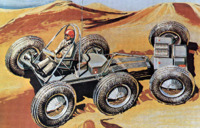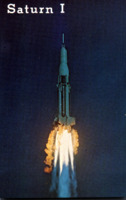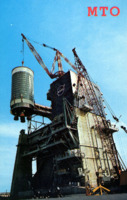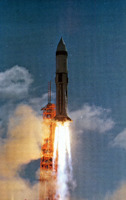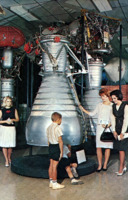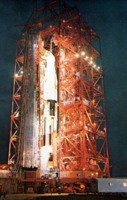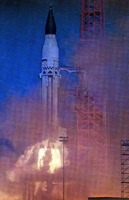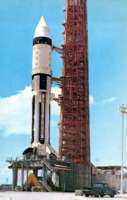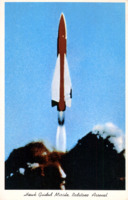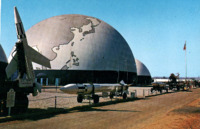
Browse Items (4796 total)
Sort by:
-
Artist's Drawing of Proposed Lunar Vehicle
Back: This is on artist's drawing of the six wheel General Motors built Mobility Test Article. The vehicle is being built by GM and tested by NASA. The concept will be used to design a vehicle for use on the moon. MSFC, at Redstone Arsenal, directs the work. -
Saturn I Launch
Front: Saturn I
Back: The eighth Saturn I launch vehicle launched from the NASA-Kennedy Space Center, Fla., (vehicle designated SA-9) is shown leaving the launch pad on Feb. 16,1965. The Saturn was developed at Marshall Space Center, HuntsviIle, Alabama. -
Mississippi Test Operations Test Stand
Front: MTO
Back: A ground test modal of the Saturn V second stage (S-ll ) is lifted into a recently completed captive test stand at the Mississippi Test Operations in Hancock County, Miss. The NASA-Marshall Space Flight Center's Mississippi Test Operations will be used for captive firing the S-ll flight stages. Ground test stage was manufactured to test out S-ll systems and the ground test facilities. -
Launch of Saturn I
Back: The second Uprated Saturn I launch vehicle (designated AS-203) leaves the launch pod at Cape Kennedy, Fla., on July 5, 1966. Saturn was developed at MSFC, Huntsville, Alabama. -
Marshall Space Flight Center's Space Orientation Center
Back: HUNTSVILLE, ALABAMA. NASA - Marshall Space Flight Center's Space Orientation Center. Rocket engine exhibits and other space-age displays are exhibited at the MSFC Space Orientation Center. -
Uprated Saturn I Launch Vehicle
Back: The Uprated Saturn I launch vehicle (SA-202) is surrounded by the service structure on the launch pad at the NASA - Kennedy Space Center, Fla. The Marshall Center, Huntsville, Ala., developed the Saturn launch vehicle. -
Fifth Saturn I Launch at Cape Kennedy
Back: The fifth Saturn I launch vehicle (SA-5) leaves the launch pad at Cape Kennedy, Fla., on Jan. 29, 1964. Nose cone painted black for special thermal experiment. -
Uprated Saturn I Launch at Cape Kennedy
Back: The second Uprated Saturn I launch vehicle (designated AS-203) stands on the launch pad at Cape Kennedy. Blunt nosecone replaced the Apollo spacecraft for this special flight. This was a liquid hydrogen test to determine how liquid hydrogen reacted in space. Television comeras were in the top of the second stage's liquid hydrogen tank. The Saturn was developed at MSFC, Huntsville, AIabama. -
Hawk Guided Missle
Front: Hawk Guided Missile, Redstone Arsenal.
Back: HAWK GUIDED MISSILE, REDSTONE ARSENAL, HUNTSVILLE, ALABAMA
This it the Army's versatile surface-to-air guided missile, designed for protection against low altitude attack. Carrying a lethal warhead, this air defense weapon system is capable of destroying attackers flying at the lowest altitudes, at ranges insuring effective protection of defended areas. Highly mobile, the system is capable of being transported with a minimum number of vehicles on the highway, by helicopter, and by aircraft. -
U.S. Army Missile Display Area
Back: U.S. ARMY MISSILE DISPLAY AREA, Redstone Arsenal, Alabama
The massive domes house innumerable displays, individual listening devices describe and explain the functions of various Rockets and Missiles. Buttons and levers operate miniature models and allow visitors to play Astronaut. The large dome is 150' in diameter and 85' tall. It is made of vinyl coated nylon, and is kept erect by air pressure. The nylon in this one dome weighs 92,000 lbs.
